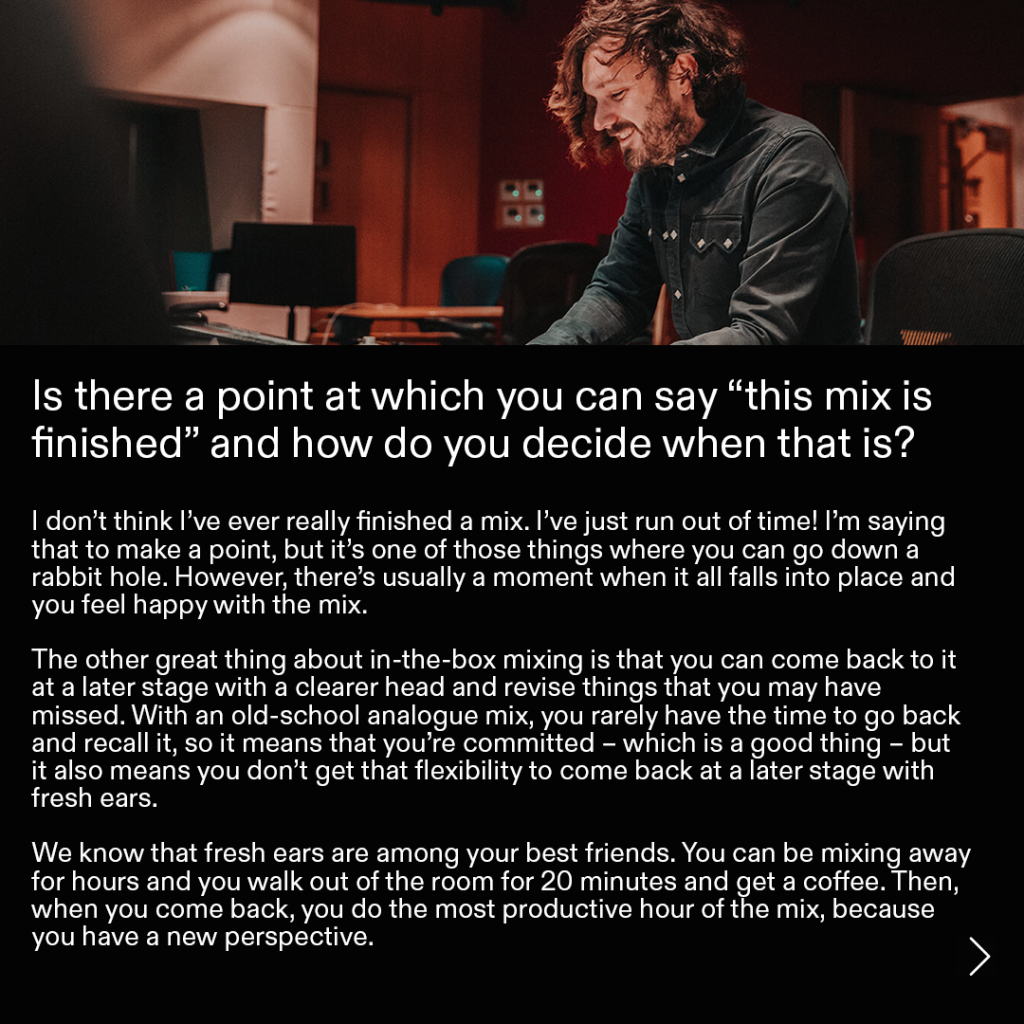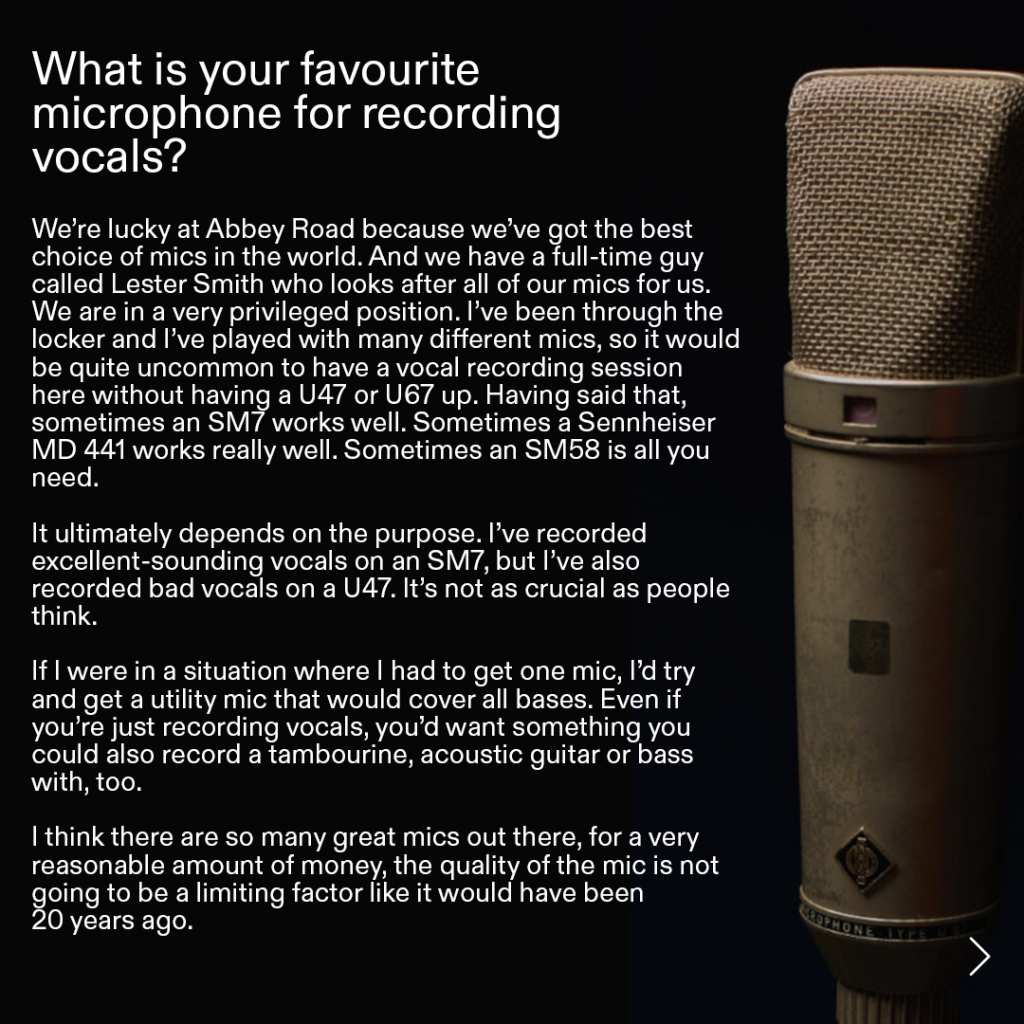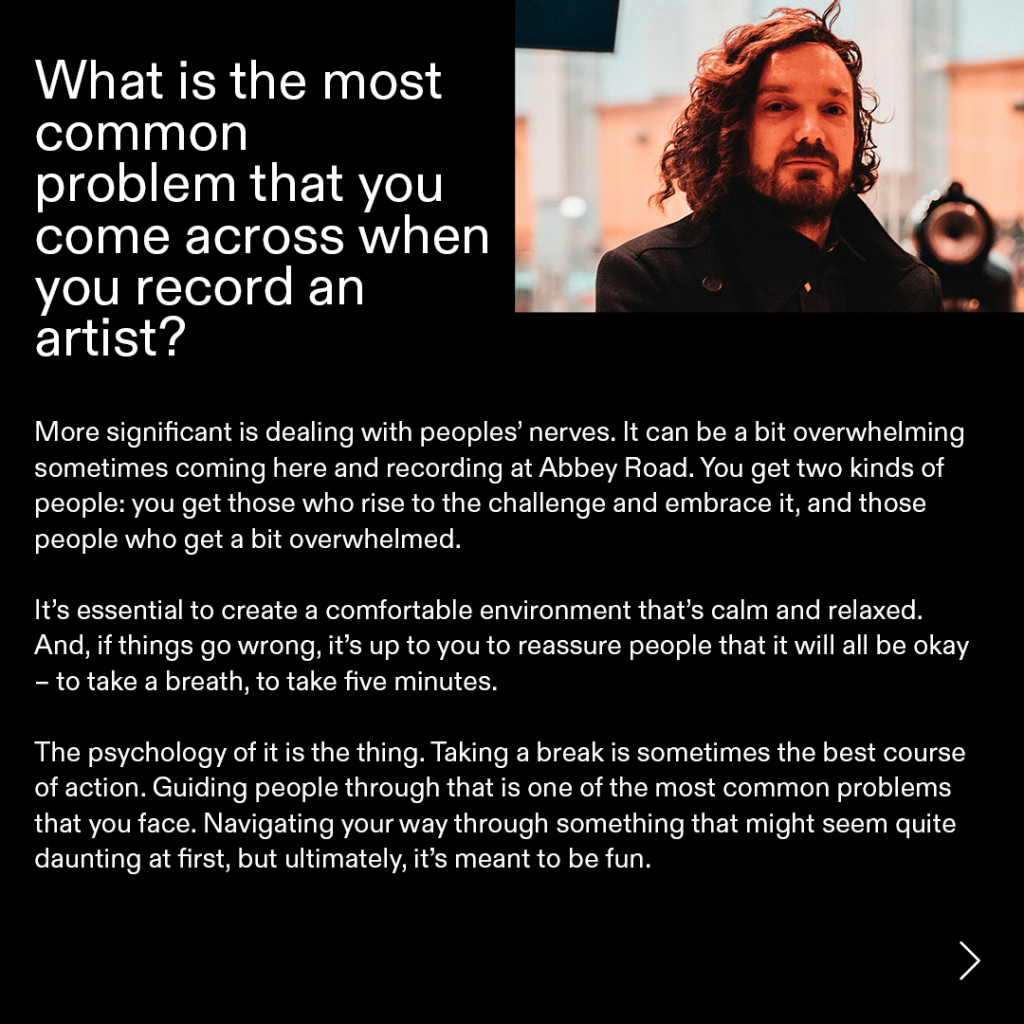We’re taking a look back at Abbey Road Studios and Music Tech’s series Ask Abbey Road, and up next is recording engineer, John Barrett.
John’s recent discography includes being the score mixer for Jonny Greenwood’s Oscar-nominated Phantom Thread score, recording the score for Steven Price’s Our Planet, as well as Michael Bay’s action thriller Ambulance. John has also recorded sessions with artists including Metronomy, Shygirl, George Ezra, JP Cooper, Slaves and Krept & Konan.
In this instalment, John is asked about when you know a mix is finished, his favourite mics for recording vocals and the common problems when recording an artist.

Is there a point at which you can say “this mix is finished” and how do you decide when that is?
I don’t think I’ve ever really finished a mix. I’ve just run out of time! I’m saying that to make a point, but it’s one of those things where you can go down a rabbit hole. However, there’s usually a moment when it all falls into place and you feel happy with the mix.
The other great thing about in-the-box mixing is that you can come back to it at a later stage with a clearer head and revise things that you may have missed. With an old-school analogue mix, you rarely have the time to go back and recall it, so it means that you’re committed – which is a good thing – but it also means you don’t get that flexibility to come back at a later stage with fresh ears.
We know that fresh ears are among your best friends. You can be mixing away for hours and you walk out of the room for 20 minutes and get a coffee. Then, when you come back, you do the most productive hour of the mix, because you have a new perspective.
The other thing is that when you’re mixing on a console, you tend not to solo things as much as you do in the box. I don’t know why that would be, but that’s a real danger, to solo things. You can get your drums sounding great in solo, then you put the bass in and it competes.
Getting a static balance and trying to approach it more like an analogue mix is crucial. Maybe you could start by putting a channel strip plug-in on every single channel and setting up your DAW like a console. Then set up a few utility reverbs and delays rather than putting a reverb plug-in on each track. It’s all about approach.
I’ve been fortunate because I started off working in the box and then came to Abbey Road and got my hands on a desk and enjoyed doing that. Then I’ve gone back and it means that I can get those colours that I would do on an analogue desk, but in the box. You can hybridise your workflow and start thinking of it more as if it was a desk mix.

What is your favourite microphone for recording vocals?
Again, this is about being prepared. Generally – and this is going to make me sound like a total charlatan – but the one that’s plugged in and working is a good place to start. As much as I’d say: “I’d love to use mic X,” if it’s not set up, and somebody wants to record the vocal quickly, there’s mileage in not being too precious about saying it has to be a specific microphone. So that’s my mantra: the one that’s plugged in and working is generally a good place to start.
That sounds a bit flippant, though. We’re lucky at Abbey Road because we’ve got the best choice of mics in the world. And we have a full-time guy called Lester Smith who looks after all of our mics for us. We are in a very privileged position. I’ve been through the locker and I’ve played with many different mics, so it would be quite uncommon to have a vocal recording session here without having a U 47 or U 67 up. Having said that, sometimes an SM7 works well. Sometimes a Sennheiser MD 441 works really well. Sometimes an SM58 is all you need.
It ultimately depends on the purpose. I’ve recorded excellent-sounding vocals on an SM7, but I’ve also recorded bad vocals on a U 47. It’s not as crucial as people think. If I were in a situation where I had to get one mic, I’d try and get a utility mic that would cover all bases. Even if you’re just recording vocals, you’d want something you could also record a tambourine, acoustic guitar or bass with, too.
I think there are so many great mics out there, for a very reasonable amount of money, the quality of the mic is not going to be a limiting factor like it would have been 20 years ago.

What is the most common problem that you come across when you record an artist?
Something that’s a real bugbear of mine is guitars. It always makes me feel slightly nervous when a guitarist starts changing strings just as you’re about to record. I’m a recovering guitarist. I was into guitar worship for years before I started playing around with faders and microphones. I always think you should bed your strings in before you come into a recording session. So, change the strings a couple of days before to give them a chance to settle in. Otherwise, you’ll have to sit there tuning up after every take.
More significant is dealing with peoples’ nerves. It can be a bit overwhelming sometimes coming here and recording at Abbey Road. You get two kinds of people: you get those who rise to the challenge and embrace it, and those people who get a bit overwhelmed.
It’s essential to create a comfortable environment that’s calm and relaxed. And, if things go wrong, it’s up to you to reassure people that it will all be okay – to take a breath, to take five minutes. The number of times when you’re recording a vocal, I genuinely believe that there’s a strange phenomenon that if you haven’t got a vocal within the first five or six takes, it’s going to be 30 takes.
Naturally, this isn’t set in stone, but there’s something psychologically where you either do a few takes or do loads of takes. There can be many takes in the middle that aren’t great because the performer is overthinking it, or getting stressed about it. Alternatively, sometimes there’s a certain magic that’s been lost. By the time you’ve got round to take 30, hopefully, some of that has come back again.
Or you could take a break. A favourite of mine, especially with singers, is to get them in to do a couple of warm-up takes and then go and get a cup of tea with them. Because by that point, they’ve settled into the headphones and the mic, and they’ve got their initial nervous energy out. They calm down, you go and have a chat with them by the coffee machine.
Then you go back and record the vocals and it seems to work. Sometimes, people want to carry on and you can see that it’s a stumbling block. That’s when it’s time to say: “Let’s just take five minutes and it will be okay.”
The psychology of it is the thing. Taking a break is sometimes the best course of action. Guiding people through that is one of the most common problems that you face. Navigating your way through something that might seem quite daunting at first, but ultimately, it’s meant to be fun.